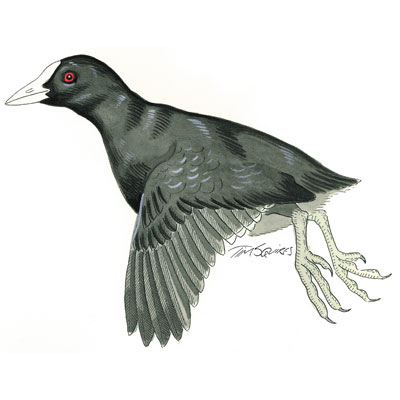 The downy, black chick looked lost and alone, stranded in the middle of one of the reservoirs at the Waterworks Reserve.
The downy, black chick looked lost and alone, stranded in the middle of one of the reservoirs at the Waterworks Reserve.
At first I tried to determine what species it was because I could not see any parents near by. Then I became concerned about its vulnerability. I’m sure it had caught the attention of a goshawk, or even a raven or currawong, who would wait to see of it eventually struggled closer to the bank, where it could be speared and eaten.
I was pleased, however, to discover that my concerns had been misplaced. Within seconds a female coot had popped up from an underwater sortie, with a beak full of fresh and juicy water plants to give her off-spring a feed.
Coots are not usually a species to attract my attention – especially as I hail originally from Britain and the same species is also found there – but this year I have been looking closely at them once again simply because they are new to the Waterworks Reserve.
I wrote earlier this year of Eurasian coots invading the Browns River at Kingston Beachfor the first time and by coincidence I saw coots on the two reservoirs in the Waterworks Reserve within days.
It was early winter and I thought the coots – a party of about six of them – must just be sheltering there between movements from one reedy lake to another at the end of the breeding season. I was surprised, though, to find the coots growing in number and hanging in for the spring, and even more surprised to find a female with a single chick because I had not seen any evidence of courtship displays, or mating and nest building.
Exactly where the nest that produced the chick was situated I could not determine, but there are reedy patches between the reservoirs at the Waterworks, so it could be hidden there.
Coots lay up to 15 eggs in a clutch but they rarely produce this number of offspring. Predators take their toll and the sight of a single chick proved that the birds of prey of the Waterworks had had rich pickings of not just coots but other species this year. The goshawks, ravens and currawongs had already taken a toll on masked lapwing chicks, and black duck ducklings as they usually do at the reserve.
The Eurasian coot, with its sooty-black plumage and gleaming white bill and frontal shield covering its forehead, is a familiar bird across Europe and Asia as well as Australia. It is often seen running across the water’s surface or swimming in huge flocks on large wetlands, but they equally often occur on small ponds. They require submerged aquatic vegetation or mats of floating waterweed, among which they forage, diving below the surface for up to 20 seconds to pluck the stems of emergent shoots.
The evidence of coot breeding might have been good news for me in my ramblings, and nature-note taking at the Waterworks, but a family who originally wrote to be me about coots arriving at the Browns River have not been so lucky.
A month ago they informed me that the coots there were breeding, writing in an email: “It’s all happening here at Kingston Beach and we are thrilled that ‘our’ coots are nesting. They are very clever little birds as they have chosen a branch of an old pine tree that is still attached to the tree but is resting in the water. As a result it floats up and down on the tide keeping the nest dry. We have been watching the pair busily building the nest and now they are taking turns to sit on it. Fascinating.”
A week later, however, there was bad news. Heavy rain from a storm had swollen the river and the nest so cleverly placed had been washed away.